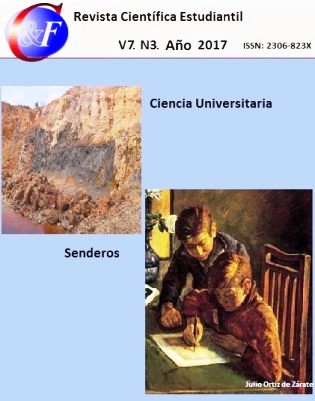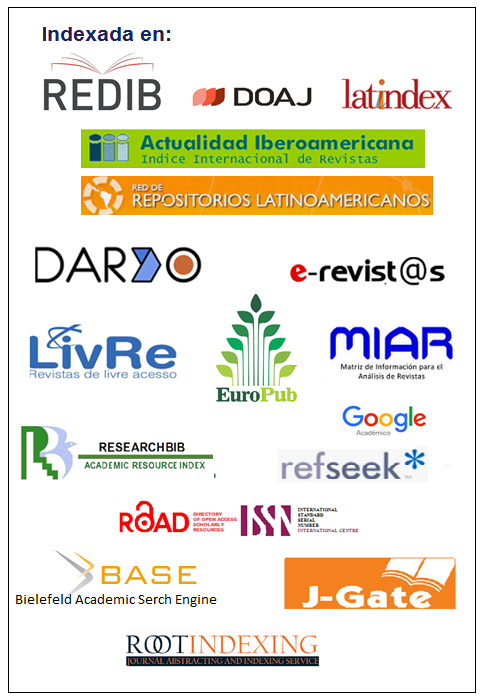Evaluation of executive functions associated with creative processing in heterosexual and homosexual orientation
Keywords:
neuropsychological process, creative thought, executive functions, sexual orientation, heterosexuals, homosexualsAbstract
We described the process and creative product, executive functions and visuospatial processing in different sexual orientations. It was taken as heterosexual and homosexual men and women. Torrance's test of creative thinking, tasks selection of sayings, semantic classifications, metamemory, verbal fluency, letter classification and visuospatial working memory, Rey-Osterreith complex figure, Klein scale of sexual orientation, depression, anxiety and impulsivity. Data were analyzed with a one-way ANOVA and Pearson's analysis. Significant differences were found in figural originality for the group of homosexual women, compared to heterosexual women; as well as a higher verbal flexibility score for homosexual men compared to heterosexuals. The successes of heterosexual men were statistically significant with respect to the scores of heterosexual women in figural fluidity. The creative characteristics expressed differently between sexual orientations are promoted by creative properties related to divergent thinking. Differences in executive functions indicate efficient cognitive styles for groups.Downloads
References
ADLER, P. & OBSTFELD, D. 2007: The role of affect in creative projects and exploratory search. Industrial and Corporate Change 16(1): 19-50.
ANDERS, S. & HAMPSON, E. 2004: Testing the prenatal androgen hypothesis: measuring digiti ratios, sexual orientation, and spatial abilities in adults. Hormones and behavior 47: 92-98.
ANNICCHIARICO, I. 2009: Psicobiología de la homosexualidad asculina: hallazgos recientes. Universitas Psychologica 8(2): 429-446.
ARDILA, A. & OSTROSKY, F. 2008: Desarrollo Histórico de las Funciones Ejecutivas. Revista Neuropsicología, Neuropsiquiatría y Neurociencias 8(1): 1-21.
ARIETI, S. 1976: Creativity: The Magic Synthesis. Basic, Nueva York.
BALFOUR, M. E.; YU, L. & COOLEN, L. M. 2004: Sexual behavior and sex-associated environmental cues activate the mesolimbic system in male rats. Neuropsychopharmacology 29(4): 718.
BOSCO, A.; LONGONI, A. & VECCHI, T. 2004: Gender effects in spatial orientation: cognitive profiles and mental strategies. Applied Cognitive Psychology 18(5): 519-532.
CANNISTRARO, P. & RAUCH, S. 2003: Neural circuitry of anxiety: evidence from structural and functional neuroimaging studies. Psychopharmacology Bulletin 37: 8-25.
CHÁVEZ, R.; GRAFF, A.; GARCÍA, J.; VAUGIER, V. & CRUZ, C. 2004: Neurobiología de la creatividad: resultados preliminares de un estudio de activación cerebral. Salud Mental 27: 38-46.
COLLAER, M. L.; REIMERS, S. & MANNING, J. T. 2007: Visuospatial performance on an internet line judgment task and potential hormonal markers: sex, sexual orientation, and 2D: 4D. Archives of sexual behavior 36(2): 177-192.
DIAMOND, A. 2013: Executive functions. Annual review of psychology 64: 135-68.
DIETRICH, A. 2004: The cognitive neuroscience of creativity. Psychonomic Bolletin and Review 11: 1011-1026.
FLAHERTY, A. 2005: Frontotemporal and dopaminergic control of idea generation and creative drive. The Journal of Comparative Neurology 493: 147-153.
FLORES, J. & OSTROSKY, F. 2008: Neuropsicología de Lóbulos Frontales, Funciones Ejecutivas y Conducta Humana. Revista Neuropsicología, Neuropsiquiatría y Neurociencias 8(1): 47-58.
FLORES, J. & OSTROSKY, F. 2012: Batería Neuropsicológica de Funciones Ejecutivas y Lóbulos Frontales. Manual Moderno, México.
FUNAHASHI, S. 2001: Neuronal mechanisms of executive control by the prefrontal cortex. Neuroscience Research 39: 147-65.
GUILFORD, J. 1962: Potentiality for creativity. Gifted Child Quarterly, 6(3), 87-90.
HASSAN, B. & RAHMAN, Q. 2007: Selective sexual orientation-related differences in object location memory. Behavioral neuroscience 121(3): 625.
HEILMAN, K.; NADEAU, S. & BEVERSDORF, D. 2003: Creative innovation: Possible brain mechanisms. Neurocase 9: 369-379.
JAUK, E.; BENEDEK, M. & NEUBAUER, A. 2012: Tackling creativity at its roots: Evidence for different patterns of EEG alpha activity related to convergent and divergent modes of task processing. International Journal of Psychophysiology 84: 219-225.
KINNUNEN, L.; MOLTZ, H.; METZ, J. & COOPER, M. 2004: Differential brain activation in exclusively ho- mosexual and heterosexual men produced by the selective serotonin reuptake inhibitor, fluoxetine. Brain Research 1024: 251-254.
KLEIN, F.; SEPEKOFF, B. & WOLF, T. 1985: Sexual Orientation. Journal of Homosexuality 11: 35–49.
LEZAK, M. 1982: The problem of assessing executive functions. International Journal of Psychology 17: 281-97.
LURIA, A. 1986: Las funciones corticales superiores del hombre. Fontamara, México.
MARTINDALE, C. 1978: Creativity, consciousness and cortical arousal. Journal of Altered States Consciousness 3: 68-87.
NEAVE, N. & MENAGED, M. 1999: Sex differences in cognition: the role of testosterone and sexual orientation. Brain and cognition 41(3): 245-262.
ORTEGA, L. 2010: Efecto del ciclo menstrual en el pensamiento creativo verbal y figural. Tesis de Licenciatura. UNAM. México.
PÁEZ, F.; JIMÉNEZ, A.; LÓPEZ, A.; ARIZA, R.; PAULO, J.; ORTEGA, H. & NICOLINI, H. 1996: Estudio de validez de la traducción al castellano de la Escala de Impulsividad de Plutchik. Salud Mental 19(3): 10-12.
RAHMAN, Q., WILSON, G. & ABRAHAMS, S. 2004b: Developmental instability is associated with neurocognitive performance in heterosexual and homosexual men, but not in women. Behavioral Neuroscience 118: 243-247.
RAHMAN, Q.; ABRAHAMS, S. & WILLSON, G. 2003a: Sexual orientation related differences un verbal fluency. Neuropsychology 17: 240-246.
RAHMAN, Q.; ABRAHAMS, S. & WILSON, G. 2003b: Born gay? The psychobiology of human sexual orientation. Personality and individual differences 34(8): 1337-1382.
RAHMAN, Q.; ANDERSSON, D. & GOVIER, E. 2005: A specific sexual orientation-related difference in navigation strategy. Behavioral Neuroscience 119: 311-316.
RAHMAN, Q.; WILSON, G. & ABRAHAMS, S. 2004a: Biosocial factors, sexual orientation and neuro- cognitive functioning. Psychoneuroendocrinology, 29, 867-881.
ROBLES, R.; VARELA, R.; JURADO, S. & PÁEZ, F. 2001: Versión Mexicana del Inventario de Ansiedad de Beck: propiedades psicométricas. Revista Mexicana de Psicología 18(2): 211-218.
ROMO, M. 1998: Teorías implícitas y creatividad artística. Arte, Individuo y Sociedad 10: 11-28.
SWAAB, D.; CHUNG, W.; KRUIJVER, F.; HOFMAN, M. & ISHUNINA, T. 2001: Structural sex differences in the human hypothalamus. Hormones and Behavior 40: 93-98.
TIRAPU, J.; GARCÍA, A.; LUNA, P.; ROIG, T. & PELEGRÍN, C. 2008: Modelos de funciones y control ejecutivo (II). Revista de neurología 46(12): 742-750.
TORRANCE, E. 1966: Thinking creatively with pictures (Figural response booklet A-B). Scholastic Testing Service, Illinois, EE.UU.
TORRANCE, E. 2008: Torrance Tests of Creative Thinking. Manual for scoring and interpreting results verbal forms A and B. Scholastic Testing Service, Illinois, EE.UU.
Published
How to Cite
Issue
Section
Esta obra está bajo una Licencia Creative Commons Reconocimiento-NoComercial 4.0 Internacional
La Revista Ciencia & Futuro es una revista de acceso abierto, todo el contenido está disponible gratuitamente sin cargo para el usuario o su institución. Los usuarios pueden leer, descargar, copiar, distribuir, imprimir, buscar o vincular los textos completos de los artículos, o utilizarlos para cualquier otro fin lícito, sin pedir permiso previo al editor o al autor. Todo lo anterior, de acuerdo con la definición de BOAI de acceso abierto.
Los autores que publican en esta revista están de acuerdo con los siguientes términos: Licencia Creative Commons Atribución-NoComercial permite que el beneficiario de la licencia tenga el derecho de copiar, distribuir, exhibir y representar la obra y hacer obras derivadas para fines no comerciales siempre y cuando reconozca y cite la obra de la forma especificada por el autor o el licenciante. Los autores pueden establecer por separado acuerdos adicionales para la distribución no exclusiva de la versión de la obra publicada en la revista (por ejemplo, situarlo en un repositorio institucional o publicarlo en un libro), con un reconocimiento de su publicación inicial en esta revista. Se permite y se anima a los autores a difundir sus trabajos electrónicamente (por ejemplo, en repositorios institucionales o en su propio sitio web) antes y durante el proceso de envío, ya que puede dar lugar a intercambios productivos, así como a una citación más temprana y mayor de los trabajos publicados (Véase The Effect of Open Access) (en inglés). Lo anterior debe realizarse siempre sobre el artículo ya publicado por Ciencia & Futuro.
Los autores mantienen el control sobre la integridad de sus trabajos y el derecho a ser adecuadamente reconocidos y citados.
A los editores se les otorgan derechos no exclusivos para publicar y distribuir.




